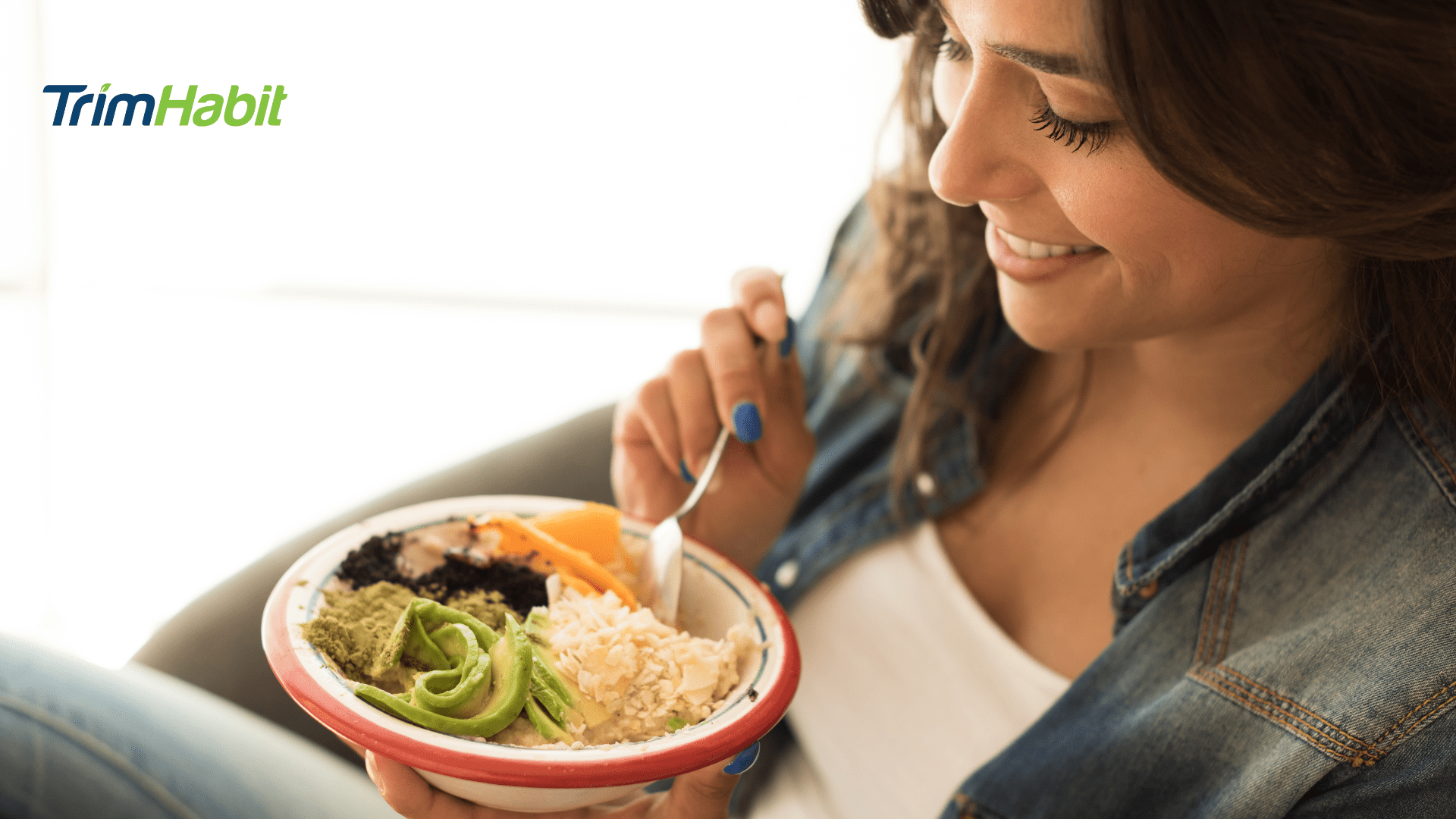Popular for its effectiveness in aiding weight reduction and blood sugar control, semaglutide has become a widely prescribed medication among individuals seeking improved health outcomes. Marketed under brand names such as Ozempic and Wegovy, this anti-obesity medication has earned acclaim for its ability to facilitate meaningful lifestyle changes. However, patients taking semaglutide frequently experience gastrointestinal side effects that may affect their appetite, nutrient absorption, and energy levels. As a result, being aware of what you eat while on this medication is essential for maintaining energy, reducing discomfort, and achieving sustained progress.
This article looks at what to eat to maintain energy on semaglutide in a practical, supportive way. We’ll walk through foods that can help you stay energized, as well as simple adjustments that may ease symptoms like nausea and slow digestion. With a focus on dietary fiber, lean proteins, and balanced meals, you can keep your strength up and feel more capable throughout your weight management experience.
Understanding Semaglutide And Energy Levels
Semaglutide is a glucagon-like peptide-1 (GLP-1) receptor agonist, a class of anti-obesity medications originally developed to manage type 2 diabetes. The active ingredient mimics a hormone in the body that enhances insulin secretion, suppresses glucagon release, and slows gastric emptying. As semaglutide slows food movement through the digestive system, patients tend to feel full longer, contributing to reduced calorie intake and, ultimately, weight loss1,2.
However, delayed gastric emptying and appetite suppression may lead some patients to stop eating prematurely or avoid meals altogether, particularly if they experience nausea or stomach pain. As the food stays in the stomach longer, it can increase the likelihood of acid reflux, bloating, or other GI distress. These adverse effects, especially in the first few weeks of treatment, can leave individuals feeling fatigued, malnourished, or lethargic.
To counteract these effects and maintain energy, it is important to eat smaller meals regularly, prioritize nutrient-dense options, and avoid foods that exacerbate symptoms. Patients should also seek medical advice when experiencing persistent or severe side effects to ensure proper adjustments are made to their care plan.
The Role Of Nutrition In Supporting Energy
When taking Ozempic or any other form of semaglutide, clinical nutrition becomes essential. The foods consumed directly influence energy levels, digestive comfort, and the ability to maintain a healthy metabolism. Choosing low glycemic foods, for example, helps stabilize blood sugar levels and reduces the risk of energy crashes or hypoglycemia (low blood sugar). Likewise, including lean protein and dietary fiber in meals promotes satiety and gradual energy release.
Patients should work closely with a healthcare provider or obesity medicine specialist to develop a personalized meal plan tailored to their needs. This plan should include the following foods:
1. Lean Protein
Protein is critical for muscle maintenance, cellular repair, and sustained energy. Lean protein sources such as chicken breast, turkey, fish, tofu, and low-fat Greek yogurt offer high biological value without contributing to excessive fat intake. These foods also promote satiety and help offset muscle loss, which can occur during rapid weight loss.
2. Whole Grains and Starchy Vegetables
Whole grains such as quinoa, brown rice, oats, and whole wheat pasta provide complex carbohydrates that deliver steady energy throughout the day. Including starchy vegetables like sweet potatoes, squash, and corn in your diet adds natural fiber and essential nutrients that support metabolic function and digestive health.
3. Fruits and Vegetables
Fresh fruits and vegetables offer vitamins, minerals, antioxidants, and hydration, all of which contribute to energy and immune support. Bananas, berries, spinach, kale, carrots, and broccoli are particularly rich in nutrients and easy to digest for most individuals. Blending fruits and vegetables into smoothies can help patients eat foods they might otherwise find difficult during periods of nausea or appetite suppression.
4. Low Fat Foods
Eating bland, low-fat foods may reduce the risk of GI symptoms like nausea, reflux, or cramping. Low-fat dairy products, skinless poultry, and steamed vegetables are gentler on the stomach and less likely to trigger adverse reactions.
5. Low Glycemic and High Fiber Options
Low glycemic foods such as lentils, barley, apples, and chickpeas prevent blood sugar spikes and crashes. High-fiber options, including beans, pears, flaxseeds, and vegetables, support regular bowel movements and help prevent constipation, another common side effect of semaglutide.
Eating Strategies For Sustained Energy
Energy levels on semaglutide are not just about food selection but also about how and when one eats. Patients often benefit from adopting mindful eating habits that reduce GI distress and improve nutrient absorption.
Eat Slowly
Eating too quickly can lead to discomfort and make it harder to gauge satiety. Patients are advised to eat slowly, chew thoroughly, and give their body time to process meals. This can help prevent overeating, bloating, and nausea.
Eat Smaller Meals More Frequently
Instead of three large meals per day, consider eating smaller meals or frequent meals spaced evenly throughout the day. This approach helps accommodate the slow digestion caused by semaglutide and ensures a consistent energy supply.
Avoid Dehydration
Dehydration can worsen fatigue and GI symptoms. Drinking water throughout the day, especially between meals, supports digestion and prevents constipation. Herbal teas and clear broths are additional options for staying hydrated without added sugar or stimulants.
Managing Gastrointestinal Side Effects
GI symptoms such as nausea, vomiting, or stomach pain are common among those newly prescribed semaglutide. While these side effects often subside within a few weeks, certain foods and eating behaviors can alleviate discomfort and improve energy in the meantime.
Anti-Nausea Foods for Semaglutide Side Effects
Incorporating ginger tea, plain crackers, applesauce, or rice can help soothe the stomach. These anti-nausea foods for semaglutide side effects are generally well-tolerated and reduce the urge to skip meals, thereby preserving energy.
Eat Bland Foods
When symptoms flare up, it’s advisable to eat bland foods such as plain toast, boiled potatoes, bananas, or oatmeal. These foods are less likely to cause irritation or worsen nausea.
Avoid High-Fat Foods and Fried Foods
High-fat and fried foods take longer to digest and can increase the sensation of fullness to the point of discomfort. Avoiding such foods may improve gastric emptying and reduce the likelihood of feeling sick after eating.
Limit Spicy Foods
While some people tolerate spicy foods well, others find that they exacerbate acid reflux and stomach upset. Limiting spicy options is often beneficial during the early stages of treatment or when experiencing GI distress.
Reduce or Eliminate Added Sugar and Sweet Foods
Sugary foods and sweet foods can cause rapid blood sugar fluctuations and may irritate the stomach lining. Replacing desserts and sugary snacks with fruits or naturally sweet alternatives can maintain energy without causing spikes or crashes.
Minimize Processed Food
Processed food often contains excessive sodium, additives, and unhealthy fats that may interfere with digestion and nutrient absorption. Whole, unprocessed foods provide more consistent energy and reduce the risk of inflammation.
Structuring A Balanced Meal Plan
Following a sustainable and energizing meal plan on semaglutide requires planning, variety, and consistency. Here is an example of a daily pattern that incorporates key recommendations:
Breakfast
- Steel-cut oats with chia seeds, banana slices, and almond milk
- Herbal tea or water
Mid-Morning Snack
- Low-fat Greek yogurt with berries
- Small handful of walnuts
Lunch
- Grilled chicken salad with leafy greens, quinoa, cherry tomatoes, and vinaigrette
- Water with lemon
Afternoon Snack
- Apple slices with almond butter
- Herbal tea
Dinner
- Baked salmon, sweet potato, and steamed broccoli
- Water
Evening Snack (if needed)
- Whole grain toast with avocado or a boiled egg
This eating pattern includes whole grains, lean proteins, fruits and vegetables, and healthy fats in modest amounts. Each meal supports blood sugar regulation, digestion, and long-lasting energy.
Following a balanced diet that supports slow digestion and provides ample nutrients is central to maintaining energy and minimizing side effects. It also forms the foundation of a healthy diet that can help prevent future weight gain once treatment ends.
The Importance Of Individualization
Not all patients respond to semaglutide in the same way, which is why dietary needs and tolerances should be individualized. For instance, some individuals may tolerate specific foods that others cannot. Maintaining a food journal and tracking symptoms can help identify which foods trigger discomfort or fatigue.
Consulting a registered dietitian or medical director of obesity medicine can provide additional insights. These professionals are trained to tailor dietary strategies that align with weight loss drugs, taking into account the unique needs of each patient.
Final Recommendations: What To Eat To Maintain Energy On Semaglutide
To maintain energy while losing weight with semaglutide, the following recommendations can serve as a helpful guide:
- Prioritize nutrient-dense foods like lean protein, whole grains, and colorful fruits and vegetables.
- Eat smaller, more frequent meals to align with slowed stomach emptying.
- Drink plenty of fluids to avoid dehydration and support digestion.
- Limit high-fat, fried, sugary, or processed food to minimize GI symptoms.
- Eat slowly, chew thoroughly, and be mindful of portion sizes.
- Keep a food diary to identify specific foods that improve or worsen symptoms.
- Consult an obesity medicine specialist or healthcare provider for personalized advice.
In summary, maintaining energy on semaglutide is not just about eating more, it’s about eating wisely. With the right strategies and support, patients can reduce side effects, preserve muscle, and fuel their bodies through the weight loss journey. While weight loss efforts often begin with medication, sustained success requires a lifelong commitment to a healthy diet, smart habits, and lasting lifestyle changes.









